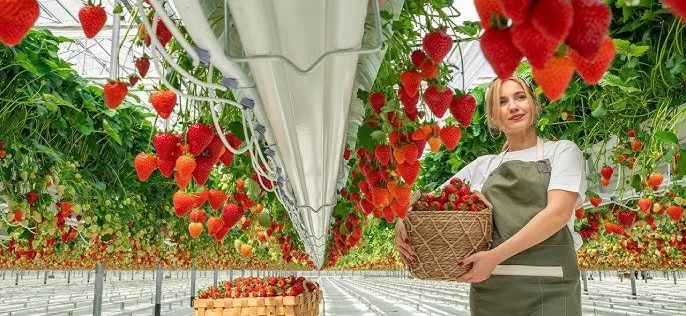Hydroponic strawberries are revolutionizing the way gardeners and commercial growers enjoy fresh, juicy berries year-round. By eliminating the limitations of soil and relying instead on nutrient-rich water solutions, hydroponic strawberry plants thrive in controlled environments with fewer pests, diseases, and unpredictable yields. For beginners, starting a hydroponic strawberry journey can be both rewarding and surprisingly straightforward—provided the right choices are made early on.
What Are Hydroponic Strawberries?
Hydroponic strawberries are simply strawberries grown without soil. Instead, their roots rest in a specially balanced water and nutrient mix, supporting rapid, healthy growth and robust fruiting cycles. This method, known as hydroponics, allows greater precision in monitoring nutrients and environmental conditions, giving growers more control and often higher yields than traditional gardening.
These benefits explain the surge in popularity of hydroponic strawberry systems both at home and in commercial greenhouses.
Why Grow Hydroponic Strawberries?
There are several key benefits to growing hydroponic strawberries, especially for those new to the concept:
-
Year-round harvests: Grow strawberries in any season, regardless of local weather.
-
Space efficiency: Vertical and stacked systems make growing more berries possible in less space.
-
Fewer pests and diseases: Without soil as a vector, there’s less risk of root-related problems.
-
Efficient water use: Hydroponics uses considerably less water than soil-based gardening.
-
Consistent yields: Carefully controlled environments lead to healthier, more reliable crops.
Choosing the Best Strawberry Hydroponic System
Before selecting plants, it’s essential to choose a strawberry hydroponic system that fits the beginner’s goals, space, and budget. Here are the main systems ideal for hydroponic strawberries:
-
Deep Water Culture (DWC): Inexpensive and simple for beginners. The roots float in nutrient solution, oxygenated by air pumps.
-
Nutrient Film Technique (NFT): Plants are grown in small channels with a constant thin layer of nutrient-rich water running beneath their roots. Great for small to medium spaces.
-
Drip System: Nutrient solution is dripped onto the plant roots at set intervals—excellent for precise feeding and scalability.
-
Vertical Tower Systems: Perfect for maximizing yield in a compact area. These systems stack plants vertically, saving floor space but requiring more setup and maintenance.
Each system has its own setup time, cost, and ease of maintenance. Beginners are often successful with DWC or NFT, due to their simplicity and widely available starter kits.
Selecting the Right Hydroponic Strawberry Plants
Not all strawberry varieties perform equally well in hydroponic setups. Choosing the right type is critical for disease resistance, yield, and flavor.
Best Hydroponic Strawberry Varieties
-
Albion: Renowned for high yields and sweet, robust flavor. Frequently recommended for hydroponic environments due to its consistent production and tolerance.
-
Seascape: Favored for disease resistance and everbearing harvests, this variety is reliable and low-maintenance—perfect for those new to hydroponics.
-
Everbearing Strawberries: As the name suggests, these plants produce fruit throughout the growing season, offering a continuous supply of berries.
When buying hydroponic strawberry plants, look for healthy starts or runners from reputable nurseries or hydroponic suppliers. Bare-root strawberries might arrive in a dormant, less-than-appealing state, but they often adapt quickly once planted and cared for properly.
Setting Up for Success: Environmental Needs
Hydroponic strawberry plants require optimal environmental conditions to flourish. These requirements are generally easier to provide indoors or in greenhouses:
-
Light: Provide at least 14-16 hours of bright, full-spectrum light daily, especially if growing indoors. LED grow lights are the industry standard.
-
Temperature: Aim for 65–75°F (18–24°C) during the day and 50-55°F (10–13°C) at night. Strawberries thrive in cooler conditions but must avoid frost.
-
Humidity: Keep humidity above 60% for efficient nutrient uptake and healthy growth.
-
Nutrient Solution: Maintain a balanced mix of nutrients, with a pH between 5.5 and 6.5. Key minerals include nitrogen, potassium, calcium, magnesium, plus micronutrients like iron and boron.
-
Ventilation: Ensure good airflow to prevent mold, fungal diseases, and excess heat buildup. Small fans are helpful in closed spaces.
Step-by-Step Guide to Starting Your Hydroponic Strawberry Garden
-
Choose your hydroponic strawberry system: DWC, NFT, Drip, or Tower—pick based on available space and willingness to maintain.
-
Buy the right plants: Healthy, disease-free bare-root or young potted hydroponic strawberry plants; consider Albion, Seascape, or similar everbearing varieties.
-
Prepare the system: Clean all components and set up your system according to manufacturer or trusted expert guidelines.
-
Mix and test your nutrient solution: Use a pre-mixed hydroponic blend designed for strawberries, carefully adjusting pH and EC (electrical conductivity).
-
Plant strawberries: Use a neutral medium like coconut coir or perlite to support roots, ensuring crowns sit above the media and roots extend below.
-
Monitor and adjust: Test nutrient and water levels frequently, and observe plant health. Adjust light, temperature, and solution as needed.
-
Pollination: Indoor hydroponic strawberries often require hand pollination with a gentle brush to ensure good fruit development.
-
Prune and maintain: Remove dead leaves, runners (unless propagating), and any unhealthy fruit to keep plants productive.
-
Harvest: Pick strawberries when fully red and plump for best flavor.
Common Beginner Mistakes and How to Avoid Them
-
Overcrowding plants: Don’t plant too many in a small system; strawberries need airflow to prevent mold.
-
Ignoring pH and nutrients: Regular testing is essential—nutrient lockout or imbalances are common beginner issues.
-
Under or overwatering: Roots must stay moist but not submerged (except in DWC), and never dry out.
-
Skipping pollination: Hydroponic systems indoors rarely provide access to bees; a simple soft paintbrush helps ensure plenty of berries.
Boosting Success: Where to Learn More
For further credible guidance and detailed hydroponic strawberry protocols, refer to authoritative university resources, such as the University of Arizona’s Hydroponic Strawberry Website. Comprehensive, science-based advice there can help fine-tune irrigation and plant nutrition for optimal yields.
Read More: 10 Benefits of Growing Hydroponic Strawberries at Home
Conclusion: The Sweet Rewards of Hydroponic Strawberries
For beginners, growing hydroponic strawberries offers a uniquely accessible path to sustainable, high-yielding gardening in nearly any setting. By choosing the right hydroponic strawberry plants, maintaining optimal environmental conditions, and regularly monitoring plant needs, even novices can enjoy delicious strawberries all year long.
With hydroponic strawberry systems—whether a simple DWC bucket, an NFT trough, or a space-saving vertical tower—anyone can experience the future of gardening today. For more technical tips on setup and environmental control, explore expert resources like the University of Arizona’s hydroponic strawberry protocols.









